Now, those don’t look all that “peculiar”, do they? It’s not that half-moon ravioli are out of the ordinary. But… the color of them is different than the usual plain flour or semolina flour, no? Much like the very first in this series… grano arso, made with “burnt flour”, or stradette, made with corn flour. These are ravioli della val pusteria, and the secret of the color… rye flour. The Val Pusteria, or in English, the Puster Valley, is located in the northern province of Trentino-Alto Adige, on the border with Austria. The ravioli are known in a bit more widespread part of that region, and the one time I’ve had them in Italy I was a bit over 100 km southwest of there in Verona, during the annual VinItaly wine fair.
This is one that no one taught me to make over my career, so I’m basing it on online recipes. After reviewing a dozen or so, they kind of came down to, shall we call it, distilled wisdom. The pasta ingredients are simple – rye flour (200 gm) and pasta flour (135 gm), roughly 3:2 in ratio, eggs (3 large), salt (½ tsp), water. Now, I’ve made rye pastas before, it’s not all that out there. But those have been “made up” pastas, not ones with traditions stretching back to… whenever. I remember making rye langanelli to accompany cibreo, a chicken liver sauce; and I made pumpernickel linguini once to accompany a bolognesa sauce made with “deli meats”, and even a corn-rye mix for a spicy prawn saute.
But, back to these ravioli. Mix the two flours and the salt together, add enough eggs to bring it together – the water is just if you need a splash more and don’t want to add another egg, which might make it too sticky. Knead it well. Given that rye has no gluten in it, you need to develop enough gluten out of the pasta flour so that the dough isn’t crumbly. In fact, I think that although it’s not traditional, if I make these again, I’d add a spoonful or so of pure gluten to the dough just to give it a more elastic texture, it wasn’t as smooth as I’d like to work with. Let it rest while you make the filling.
Spinach (1 large bunch, 250 gm), 1 onion, 2 garlic cloves, ricotta (500 gm), breadcrumbs (handful, probably about 1/3 cup), salt, pepper, nutmeg.
Finely chopped the onions and garlic and sauteed them in a little butter (this part of Italy is more about butter than olive oil) until translucent. Chop the spinach and add to the pan along with the spices, saute until all the liquid is evaporated out. Add the breadcrumbs and saute just long enough to lightly toast them and absorb any remaining liquid. Squeeze out the excess liquid from the ricotta (wrap it up in a kitchen towel and squeeze it out as best you can), and then mix together, off the heat. Let the filling cool.
Roll out the pasta to pretty much as thin as you can make it for these ravioli, you want it delicate. Keep the parts you’re not working with covered with a towel, even a slightly damp one, to prevent them from drying out – I’ve got the back ones uncovered just for the photo.
Cut rounds out of the pasta and top them with a small spoonful of the filling. The general consensus seemed to be 7-8 cm rounds, or roughly 3″, and I used a 3″ cutter, and a melon baller for the scoop of filling.
Lightly wet the rounds halfway around the edge, fold over the filling, and press to seal well. This dough dries out quickly, so you need to either work fast, or work in smaller batches of just a few at a time. Place on a baking sheet dusted with semolina so they don’t stick. I wasn’t using these until later in the evening, so once the tray was full, I stuck it in the freezer. These can go direct from the freezer into boiling salted water to cook. (The quantities above made roughly 85-90 ravioli.)
And, when you’re ready to cook them, make a good quantity of browned butter (this seemed to be a point of contention between various recipes, whether the butter should be browned, or just melted, since I’m a fan of browned butter, I went that way), finished off with a sprinkle of salt, and lots of chopped chives thrown in off the heat at the last moment.
And, coat the now cooked ravioli in the butter sauce and grate some cheese over it. The most traditional would be a grana type cheese – in particular to the region, grana del trentino, but that may not be readily available, and either grana padano or parmigiano-reggiano are perfectly fine substitutes, and various of the recipes recommended one or the other. I used our local reggianito cheese as the closest I had on hand.
Simple, tasty, delicate ravioli. I’d happily eat them again, and will, because there’s still a bunch of them in the freezer!
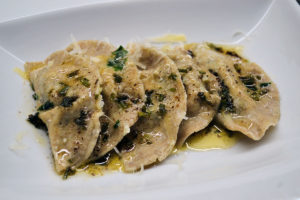
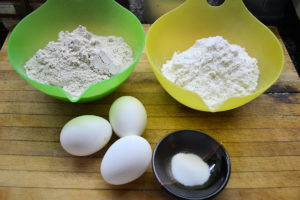
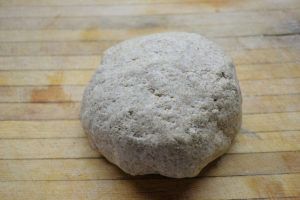
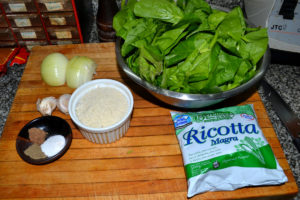
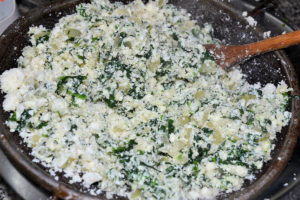
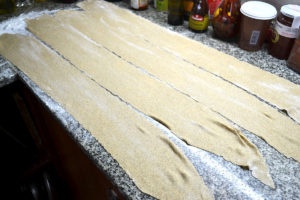
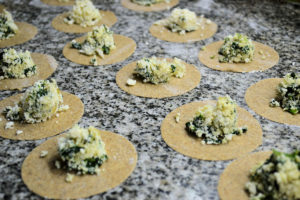
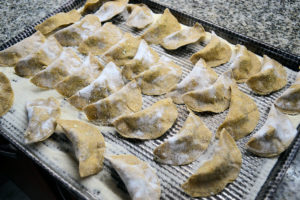
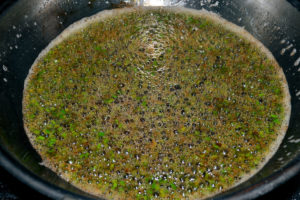
[…] my previous post, I laid out a step by step recipe for ravioli della val pusteria, which we served up this week on […]
Have you ever tried Pizzoccheri Della Valtellina? When I was still working in a office job in Italy, it was a regula at the company’s cafeteria and it soon became one ogni my favorite dishes. In Italy you can buy the pizzicheri fresh or dried (it is a kind of pasta made with some kind of wheat whose English name j am unaware of) and you just need to add the rest. However, my mom cannot do it and so I have been only dreaming off pizzocheri since I started freelancing. I thought to make them, but in Argentina I am not ever sure about the kind of flour I should use.
In English, it’s buckwheat flour (although I’ve also seen it made with rye flour), and yes, one of my favorite dishes.
https://www.saltshaker.net/20090810/north-by-northwest-2
and even a more fancied up version, done almost like a lasagna, here on a menu just a few weeks ago: https://www.saltshaker.net/20180327/2018-menu-12
Here in Argentina look for harina saracena, not easy to find, I usually buy it at Casa Polti, on Juramento near Ciudad de la Paz, sometimes I see it Barrio Chino, but not often.
And hmm, hey, that’s a good one for one of the upcoming step-by-step pastas!